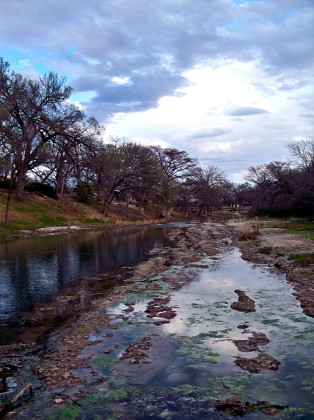 Trout fishing is about the last thing that comes to mind when most people think of Texas. More often, images of cactus, flashy bass boats, and John Wayne pop up when the Lone Star State is mentioned. Yet a Texas trout stream is exactly where we found ourselves a few weeks ago during spring break. The Texas Hill Country (and the state as a whole, for that matter) has long intrigued me, both for fishing opportunities and the character of the area. I’m not sure if it’s the pictures of obese, popper-crushing largemouths, or the thought of spring-fed rivers coursing through arid, desert-like terrain, or the starkly beautiful and majestic hills and bluffs, but for some reason the Hill Country and the rivers that flow through it have haunted my thoughts more than a few times.
Trout fishing is about the last thing that comes to mind when most people think of Texas. More often, images of cactus, flashy bass boats, and John Wayne pop up when the Lone Star State is mentioned. Yet a Texas trout stream is exactly where we found ourselves a few weeks ago during spring break. The Texas Hill Country (and the state as a whole, for that matter) has long intrigued me, both for fishing opportunities and the character of the area. I’m not sure if it’s the pictures of obese, popper-crushing largemouths, or the thought of spring-fed rivers coursing through arid, desert-like terrain, or the starkly beautiful and majestic hills and bluffs, but for some reason the Hill Country and the rivers that flow through it have haunted my thoughts more than a few times.
——————–
The wind burst through the giant cypress trees as I attempted to lob my indicator nymph rig in the general direction of “upstream”. Braden and I had been fishing the trophy section of the Guadalupe, home to planted rainbows up to twenty inches, for just about an hour, but the stream was starting to puzzle us. You never know what to expect when fishing a new trout stream, and this one had taken us a bit by surprise. Here the Guadalupe was flowing up against a towering bluff, the current moving quite slowly, almost as if it were distracted from its inescapable task of moving downstream. Most of the water was quite shallow with large slabs of rock cutting out into the river before the water abruptly dropped off into a deep, narrow trench. The dilemma wasn’t so much a problem of finding the fish, as most of the river was about a foot deep, but rather knowing right where the fish should be, sitting out of sight somewhere in the blue waters. I had read a fishing report earlier in the week that ran something like “if you know there are fish in the water (where else would they be), keep switching flies ’till you hook up”. I now understood exactly what he was saying.
——————–
A rare and unique river rising in an even rarer and more unique area, the Guadalupe River first emerges from springs in the headwaters in a similar fashion to most spring creeks in the Driftless Area. The Guad, along with other Hill Country streams, is fed by the Edwards Aquifer, a system characterized by a layer of porous, water-holding limestone. This limestone is the lifeblood of the crystal clear rivers in the Hill Country. Much like in the karst topography found in the Driftless Area and Pennsylvania, the limestone collects and transfers groundwater, eventually regurgitating it in the form of spring fed rivers and streams. The Guadalupe is one of these streams that arises from springs, bursts with life, and flows down through the contrastingly stark terrain. Bass and other warmwater species thrive in the upper stretches before it flows into Canyon Lake, a massive impoundment of over eight thousand acres of deep, blue water. When the Guad re-emerges from Canyon dam, invigorated by its journey through the lake, its slightly blue waters are icy cold – and able to sustain trout, making it the southernmost trout fishery in the United States.
——————–
The indicator rig wasn’t doing me much good with the slow current and fierce wind. I had only seen one trout the whole afternoon, a thick-shouldered bruiser rainbow that lazily floated up from the blue waters, grabbed something microscopic off the calm surface, and sank back into the depths, out of sight, just as quickly as he appeared. I chopped off my clumsy nymph rig and rummaged through my fly box until I uncovered a #12 bead head Chickabou Bugger.
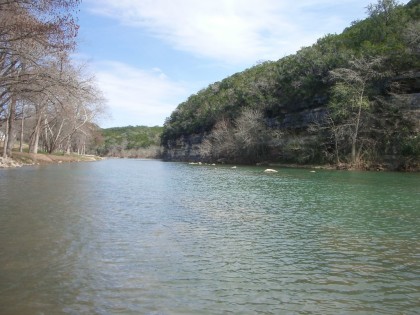
Streamers, I’ve found, are best suited for fishing this type of water, which seemed to be unable to make up its mind between behaving like a stream or a stillwater. The trout that live there seem to have a hard time, too, cruising the slow current in all directions, yet always keeping a wary eye out for food being washed down by the gentle current. They can be both the toughest and easiest fish in the stream to catch. Some are warier than a whitetail during gun season. Others – especially stockers – appear to be bored with their somewhat monochromatic environment, eager to pound the daylights out of anything than comes in sight. Those were the ones I was after.
Nothing really happened for the first few holes. Though there was a gentle current, I followed my standard stillwater streamer fishing procedure – tossing the woolly bugger upstream, letting it sink through the almost imperceptible current for what seemed like an eternity, and slowly dragging it back with a varied cadence of tugs and twitches and pulls. I changed it up a few times before a trout finally found it to his liking. The familiar tug of a fish – the first I’ve felt on a fly rod for nearly five months – coursed through the rod as a strong rainbow headed for the other side of the river. He rolled on the surface a few times before I scooped him into the net. A stocker, no doubt, but a great fish to start the season!
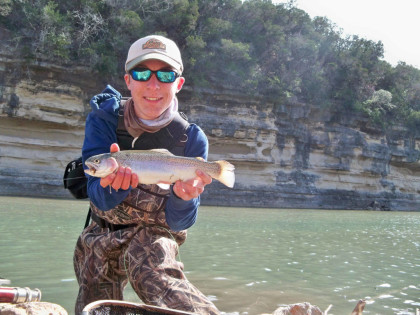
After releasing the trout, Braden and I decided to check out a different stretch of stream. We ventured out of the trophy section and hit the deep pool right below the dam. The pool was bordered by a big slab of cement and barbed-wire fences as the water tumbled out of the spillway – hardly a scenic spot, but definitely worthy of investigation. This stretch receives a healthy dose of smaller rainbows from the Texas Parks and Wildlife Department. 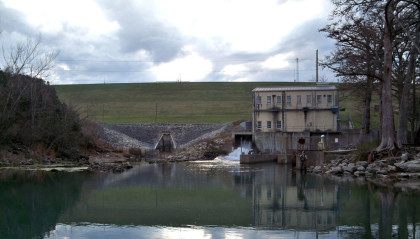
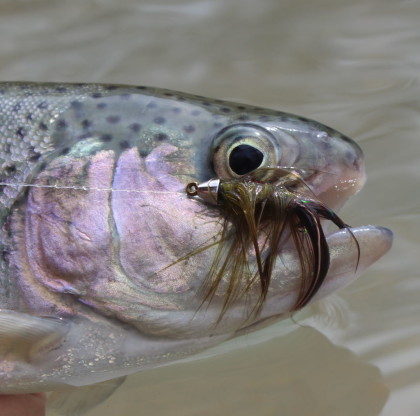
It only took a few casts before a spunky ten inch rainbow smacked my streamer. Every couple casts a trout would dart out of the turbulent blue waters and slash at our streamers Action was non-stop for the next hour, and Braden and I pulled in around sixteen little ‘bows on woolly buggers before a thunderstorm pushed us off the water just before dark. Streamers were definitely the ticket for these aggressive rainbows, accounting for all our trout besides one little guy that ate a Tellico-style soft hackle. 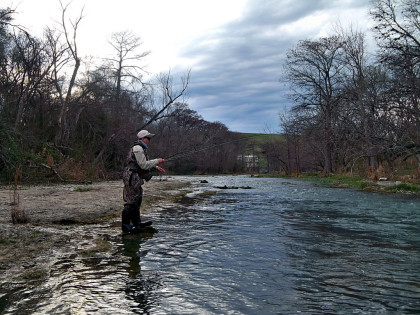
The hot Texas sun made a full appearance the next time we hit the water a few days later, but the trout didn’t seem to mind. We hit the same stretch below the dam. It was more like bluegill fishing than your typical trout scenario – small flies and light tippets had no place. Stretching all of eight inches – or twelve for a big one -, the fish weren’t monsters, but still lots of fun on streamers. Most of the time the fly wouldn’t survive for more than a minute before being jolted by an eager rainbow. It wasn’t hard fishing, but it’s the kind of day every fly fisherman needs once in a while. Noah tagged along this time and fished his glass 4 wt., which was a blast with the spunky rainbows. Each time his hook managed to stick, the little rod would bend and throb profusely under the strain of the small trout.
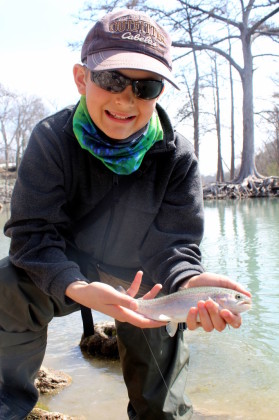
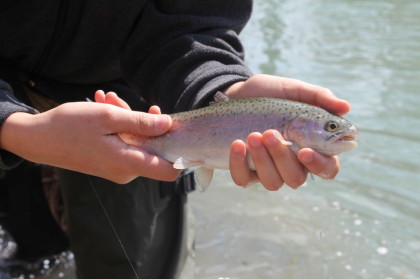 I lost track after half a dozen rainbows. We had a blast pulling fish out of the pool for the next hour or two. I played around with a few flies and rigs, but a woolly bugger with a small split shot was a sufficient offering most of the time. Braden tossed a #6 with a conehead – a big meal for the little ‘bows – and did quite well. Smaller streamers also produced a good share of trout.
I lost track after half a dozen rainbows. We had a blast pulling fish out of the pool for the next hour or two. I played around with a few flies and rigs, but a woolly bugger with a small split shot was a sufficient offering most of the time. Braden tossed a #6 with a conehead – a big meal for the little ‘bows – and did quite well. Smaller streamers also produced a good share of trout. 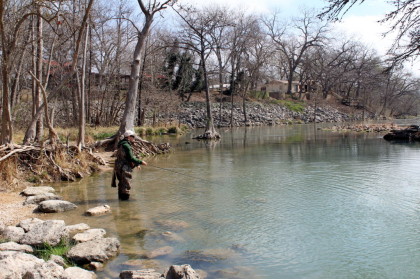
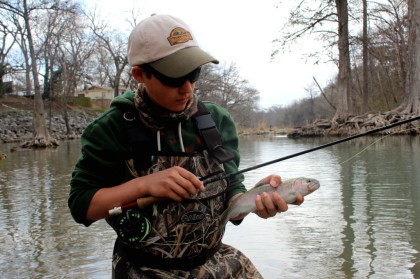
Texas is hardly a place you’d expect to find trout, but it hosts a surprisingly good fishery. Though the trout in the Guadalupe may not be wild or particularly discerning, it’s a blast to hit the water and toss streamers or nymphs to big rainbows in the heart of the Lone Star State.
It seems that winter still has a faint grip on the Northwoods, but things should start to warm up and melt pretty soon. Until then, we’ll be tying some bugs in preparation for the upcoming statewide trout opener, which is only a couple weeks away!
Tight lines,
Conner
Also, be sure to “like” us on Facebook for Driftless fishing reports, fly patterns, and the latest happenings on the blog!
Local Texas fly shops….

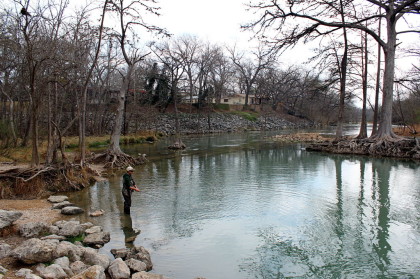
1 comment